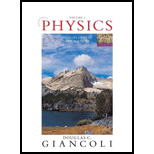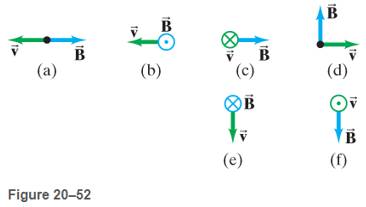
Physics: Principles and Applications -- Pearson e Text Instant Access (Pearson+)
7th Edition
ISBN: 9780137679065
Author: Douglas Giancoli
Publisher: PEARSON+
expand_more
expand_more
format_list_bulleted
Concept explainers
Textbook Question
Chapter 20, Problem 12P
Find the direction of the force on a negative charge for each diagram shown in Fig. 20-52 0:where (green) is the velocity of the charge and B (blue) is the direction of the magnetic field. (& means the vector points inward. © means it points outward, toward you.)

Expert Solution & Answer
Want to see the full answer?
Check out a sample textbook solution
Students have asked these similar questions
Solve and answer the question correctly please. Thank you!!
Solve and answer the question correctly please. Thank you!!
r
2. Measuring Length
mm 1
cm
2
3
INCH 1 16THS
5 6 7 8 9
10 11
FAIRGATE COLD SPRING, NEW YORK
2
3
12
1.
Using the metric (top) scale only, what units are being used for the long lines
with the numbers? Hint: Remember that 2.54 cm = 1 in.
2.
What are the units of the small lines?
3. How many decimal places should be recorded using this tool?
4. What is the length of the red line? Note: Make sure to use the correct units
and decimal places.
5. Now observe your ruler. What metric units are used on your ruler?
6. How many decimal places should you record when using your ruler?
7.
Measure a box, book, coin and can and fill out the data table below. Make
sure to use units and the correct number of decimal places for your ruler.
Table 1: Measuring Length Data Table
Object
Length of the box
Length
Local PR Distribution Only $99/Release. Get Started On Our Website Now!
V
2
217
Chapter 20 Solutions
Physics: Principles and Applications -- Pearson e Text Instant Access (Pearson+)
Ch. 20 - Prob. 1OQCh. 20 - Prob. 1QCh. 20 - Prob. 2QCh. 20 - Prob. 3QCh. 20 - Prob. 4QCh. 20 - Prob. 5QCh. 20 - Two iron bars attract each other no matter which...Ch. 20 - Prob. 7QCh. 20 - Prob. 8QCh. 20 - Prob. 9Q
Ch. 20 - Prob. 10QCh. 20 - Prob. 11QCh. 20 - Prob. 12QCh. 20 - 13. Explain why a strong magnet held near a CRT...Ch. 20 - Prob. 14QCh. 20 - Prob. 15QCh. 20 - Prob. 16QCh. 20 - Prob. 17QCh. 20 - If a moving charged particle is deflected sideways...Ch. 20 - Prob. 19QCh. 20 - Prob. 20QCh. 20 - Prob. 21QCh. 20 - Prob. 22QCh. 20 - Prob. 23QCh. 20 - Why will either pole of a magnet attract an...Ch. 20 - Prob. 25QCh. 20 - Prob. 1MCQCh. 20 - Prob. 2MCQCh. 20 - Prob. 3MCQCh. 20 - Prob. 4MCQCh. 20 - Prob. 5MCQCh. 20 - Prob. 6MCQCh. 20 - Prob. 7MCQCh. 20 - Prob. 8MCQCh. 20 - Prob. 9MCQCh. 20 - Prob. 10MCQCh. 20 - Prob. 11MCQCh. 20 - Prob. 12MCQCh. 20 - Prob. 1PCh. 20 - Prob. 2PCh. 20 - A 240-m length of wire stretches between two...Ch. 20 - Prob. 4PCh. 20 - Prob. 5PCh. 20 - Prob. 6PCh. 20 - Prob. 7PCh. 20 - Prob. 8PCh. 20 - Prob. 9PCh. 20 - Prob. 10PCh. 20 - Prob. 11PCh. 20 - Find the direction of the force on a negative...Ch. 20 - Prob. 13PCh. 20 - Prob. 14PCh. 20 - Prob. 15PCh. 20 - For a particle of mass mand charge q moving in a...Ch. 20 - Prob. 17PCh. 20 - Prob. 18PCh. 20 - Prob. 19PCh. 20 - Prob. 20PCh. 20 - Prob. 21PCh. 20 - Prob. 22PCh. 20 - Prob. 23PCh. 20 - Prob. 24PCh. 20 - Jumper cables used to start a stalled vehicle...Ch. 20 - Prob. 26PCh. 20 - Prob. 27PCh. 20 - A vertical straight wire carrying an upward 28-A...Ch. 20 - Prob. 29PCh. 20 - Prob. 30PCh. 20 - Prob. 31PCh. 20 - Prob. 32PCh. 20 - Prob. 33PCh. 20 - A straight stream of protons passes a given point...Ch. 20 - Prob. 35PCh. 20 - Prob. 36PCh. 20 - Prob. 37PCh. 20 - A power line carries a current of 95 A west along...Ch. 20 - Prob. 39PCh. 20 - Prob. 40PCh. 20 - Prob. 41PCh. 20 - Prob. 42PCh. 20 - Prob. 43PCh. 20 - Prob. 44PCh. 20 - Prob. 45PCh. 20 - Prob. 46PCh. 20 - A 550-turn horizontal solenoid is 15 cm long. The...Ch. 20 - Prob. 48PCh. 20 - Prob. 49PCh. 20 - (a) Use Ampere’s law to show that the magnetic...Ch. 20 - Prob. 51PCh. 20 - Prob. 52PCh. 20 - Prob. 53PCh. 20 - A circular coil 12.0 cm in diameter and containing...Ch. 20 - Prob. 55PCh. 20 - Prob. 56PCh. 20 - Prob. 57PCh. 20 - One form of mass spectrometer accelerates ions by...Ch. 20 - Prob. 59PCh. 20 - Prob. 60PCh. 20 - Prob. 61PCh. 20 - Prob. 62PCh. 20 - 63. * (II) The following are some values of Band...Ch. 20 - Prob. 64GPCh. 20 - Prob. 65GPCh. 20 - Prob. 66GPCh. 20 - Prob. 67GPCh. 20 - Prob. 68GPCh. 20 - Prob. 69GPCh. 20 - Prob. 70GPCh. 20 - Prob. 71GPCh. 20 - Prob. 72GPCh. 20 - Prob. 73GPCh. 20 - Prob. 74GPCh. 20 - Magnetic fields are very useful in particle...Ch. 20 - Prob. 76GPCh. 20 - Prob. 77GPCh. 20 - Prob. 78GPCh. 20 - Prob. 79GPCh. 20 - Prob. 80GPCh. 20 - Prob. 81GPCh. 20 - Prob. 82GPCh. 20 - Prob. 83GPCh. 20 - Prob. 84GPCh. 20 - Prob. 85GPCh. 20 - Prob. 86GPCh. 20 - Prob. 87GPCh. 20 - The cyclotron (Fig. 20-72?) is a device used to...Ch. 20 - 89. Three long parallel wires are 3.8 cm from one...Ch. 20 - Prob. 90GPCh. 20 - Prob. 91GPCh. 20 - Prob. 92GP
Additional Science Textbook Solutions
Find more solutions based on key concepts
6. A construction worker with a weight of 850 N stands on a roof that is sloped at 20°. What is the magnitude...
Physics for Scientists and Engineers: A Strategic Approach, Vol. 1 (Chs 1-21) (4th Edition)
Fibrous connective tissue consists of ground substance and fibers that provide strength, support, and flexibili...
Human Biology: Concepts and Current Issues (8th Edition)
You microscopically examine scrapings from a case of Acan-thamoeba keratitis. You expect to see a. nothing. b. ...
Microbiology: An Introduction
Plants use the process of photosynthesis to convert the energy in sunlight to chemical energy in the form of su...
Campbell Essential Biology (7th Edition)
Why does a one-step growth curve differ in shape from that of a bacterial growth curve?
Brock Biology of Microorganisms (15th Edition)
Which type of cartilage is most plentiful in the adult body?
Anatomy & Physiology (6th Edition)
Knowledge Booster
Learn more about
Need a deep-dive on the concept behind this application? Look no further. Learn more about this topic, physics and related others by exploring similar questions and additional content below.Similar questions
- Which of the following best describes how to calculate the average acceleration of any object? Average acceleration is always halfway between the initial acceleration of an object and its final acceleration. Average acceleration is always equal to the change in velocity of an object divided by the time interval. Average acceleration is always equal to the displacement of an object divided by the time interval. Average acceleration is always equal to the change in speed of an object divided by the time interval.arrow_forwardThe figure shows the velocity versus time graph for a car driving on a straight road. Which of the following best describes the acceleration of the car? v (m/s) t(s) The acceleration of the car is negative and decreasing. The acceleration of the car is constant. The acceleration of the car is positive and increasing. The acceleration of the car is positive and decreasing. The acceleration of the car is negative and increasing.arrow_forwardWhich figure could represent the velocity versus time graph of a motorcycle whose speed is increasing? v (m/s) v (m/s) t(s) t(s)arrow_forward
arrow_back_ios
SEE MORE QUESTIONS
arrow_forward_ios
Recommended textbooks for you
 Glencoe Physics: Principles and Problems, Student...PhysicsISBN:9780078807213Author:Paul W. ZitzewitzPublisher:Glencoe/McGraw-Hill
Glencoe Physics: Principles and Problems, Student...PhysicsISBN:9780078807213Author:Paul W. ZitzewitzPublisher:Glencoe/McGraw-Hill College PhysicsPhysicsISBN:9781938168000Author:Paul Peter Urone, Roger HinrichsPublisher:OpenStax College
College PhysicsPhysicsISBN:9781938168000Author:Paul Peter Urone, Roger HinrichsPublisher:OpenStax College Principles of Physics: A Calculus-Based TextPhysicsISBN:9781133104261Author:Raymond A. Serway, John W. JewettPublisher:Cengage Learning
Principles of Physics: A Calculus-Based TextPhysicsISBN:9781133104261Author:Raymond A. Serway, John W. JewettPublisher:Cengage Learning Physics for Scientists and Engineers: Foundations...PhysicsISBN:9781133939146Author:Katz, Debora M.Publisher:Cengage Learning
Physics for Scientists and Engineers: Foundations...PhysicsISBN:9781133939146Author:Katz, Debora M.Publisher:Cengage Learning
 College PhysicsPhysicsISBN:9781305952300Author:Raymond A. Serway, Chris VuillePublisher:Cengage Learning
College PhysicsPhysicsISBN:9781305952300Author:Raymond A. Serway, Chris VuillePublisher:Cengage Learning

Glencoe Physics: Principles and Problems, Student...
Physics
ISBN:9780078807213
Author:Paul W. Zitzewitz
Publisher:Glencoe/McGraw-Hill

College Physics
Physics
ISBN:9781938168000
Author:Paul Peter Urone, Roger Hinrichs
Publisher:OpenStax College

Principles of Physics: A Calculus-Based Text
Physics
ISBN:9781133104261
Author:Raymond A. Serway, John W. Jewett
Publisher:Cengage Learning

Physics for Scientists and Engineers: Foundations...
Physics
ISBN:9781133939146
Author:Katz, Debora M.
Publisher:Cengage Learning


College Physics
Physics
ISBN:9781305952300
Author:Raymond A. Serway, Chris Vuille
Publisher:Cengage Learning
Magnets and Magnetic Fields; Author: Professor Dave explains;https://www.youtube.com/watch?v=IgtIdttfGVw;License: Standard YouTube License, CC-BY